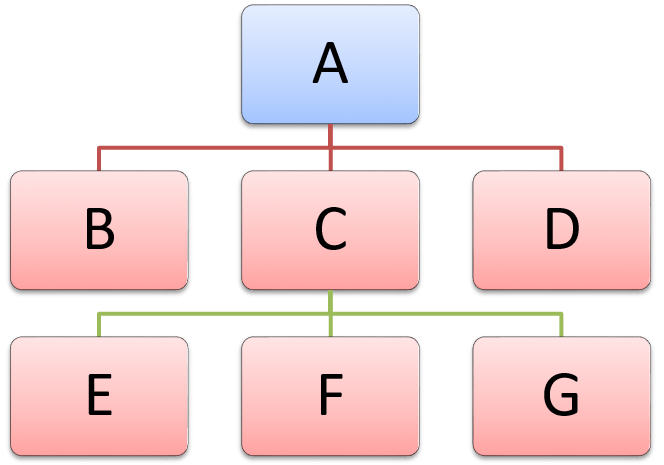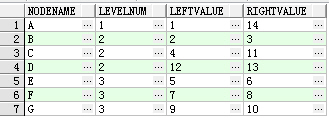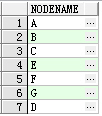This article is from Li Mingzi's csdn blog( http://blog.csdn.net/free1985 For commercial reprints, please contact the blogger for authorization. For non-commercial reprints, please indicate the source.
Abstract: this paper introduces the implementation of plsql-based code storage in the first root traversal tree with layer number. The code in this paper is written in March 2014. In addition, this paper provides the storage process source code and sample examples of test table creation statement, insertion node, acquisition of direct child node, acquisition of self and descendant node, acquisition of path from root to designated node, deletion node and so on.
1 Storage Mode Introduction
The main idea of the storage method of the first root traversal tree with layer number is to maintain the hierarchical relationship of the tree structure by recording the sequence number of the first visit to the node in the first root traversal (hereinafter referred to as the left value) and the order number of the second visit in the backtracking (hereinafter referred to as the right value). From the concept of root traversal, we can see that the left value of the child node must be greater than the left value of the parent node, and the right value must be less than the right value of the parent node. Combined with sorting operation, it is easy to query tree data without recursion. In addition, on the basis of recording the left and right values, the method also maintains the layer number of the node to reduce the time complexity of querying the direct (parent) child nodes.
The storage structure of the first root traversal tree with layer numbers is shown in Table 1-1.
Table 1-1 Storage structure of first-root traversal tree with layer number 
2 tabular statement
The table building statement of the first root traversal tree with layer number under Oracle is as follows.
CREATE TABLE TREE
(
NODENAME NVARCHAR2(50) NOT NULL,
LEVELNUM NUMBER(8) NOT NULL,
LEFTVALUE NUMBER(8) NOT NULL,
RIGHTVALUE NUMBER(8) NOT NULL );
COMMENT ON TABLE TREE IS 'Traversal Tree with Layer First Root'
;
COMMENT ON COLUMN TREE.NODENAME IS 'Node name'
;
COMMENT ON COLUMN TREE.LEVELNUM IS 'Layer number, starting from 1'
;
COMMENT ON COLUMN TREE.LEFTVALUE IS 'First root traversal left value'
;
COMMENT ON COLUMN TREE.RIGHTVALUE IS 'First root traversal right value'
;
ALTER TABLE TREE ADD CONSTRAINT PK_NODENAME
PRIMARY KEY (NODENAME)
;
3 Insert Node
3.1 Implementation
The insertion node stored procedure code is as follows:
procedure InsertNode --Insert Node
(parentName in nvarchar2, --Parent node name, empty when inserting root
nodeName in nvarchar2 --Node name
) is
parentRight TREE.RIGHTVALUE%type; --Right value of parent node
parentLevel TREE.LEVELNUM%type; --Parent node hierarchy
begin
if parentName is null then
insert into TREE values (nodeName, 1, 1, 2);
else
--Get the right value of the parent node
select RIGHTVALUE, LEVELNUM
into parentRight, parentLevel
from TREE
where NODENAME = parentName;
update TREE
set LEFTVALUE = LEFTVALUE + 2
where LEFTVALUE > parentRight - 1;
update TREE
set RIGHTVALUE = RIGHTVALUE + 2
where RIGHTVALUE > parentRight - 1;
insert into TREE
values
(nodeName, parentLevel + 1, parentRight, parentRight + 1);
end if;
end InsertNode;3.2 Test
For example, we want to create a tree as shown in Figure 3-1. 
Figure 3-1 Test Case Tree Structure Diagram
To create the tree above, you can call the following sample code:
begin
-- Call the procedure
tree_package.InsertNode('', 'A');
tree_package.InsertNode('A', 'B');
tree_package.InsertNode('A', 'C');
tree_package.InsertNode('A', 'D');
tree_package.InsertNode('C', 'E');
tree_package.InsertNode('C', 'F');
tree_package.InsertNode('C', 'G');
end; After executing the test code, the table record is updated to the state shown in Table 3-1.
Table 3-1 Table records after insertion of nodes 
4 Get direct subnodes
4.1 Implementation
Get the direct child stored procedure code as follows:
procedure GetChildren --Get child nodes
(parentName IN NVARCHAR2, --Parent Node Name
children OUT RETCURSOR --Child node name
) is
parentLeft TREE.LEFTVALUE%type; --Left value of parent node
parentRight TREE.RIGHTVALUE%type; --Right value of parent node
parentLevel TREE.LEVELNUM%type;
begin
select LEFTVALUE, RIGHTVALUE, LEVELNUM
into parentLeft, parentRight, parentLevel
from TREE
where NODENAME = parentName;
open children for
select NODENAME
from TREE
where LEFTVALUE between parentLeft and parentRight
and LEVELNUM = parentLevel + 1
order by LEFTVALUE asc;
end GetChildren;4.2 Test
For example, we want to get the direct child node of node A and call GetChildren to get the cursor as shown in Table 4-1.
Table 4-1 Gets the result cursor of the direct child node 
5 Get the current node and descendant node
5.1 Implementation
Get the stored procedure code for the current node and its descendants as follows:
procedure GetDescendants --Getting descendant nodes
(parentName IN NVARCHAR2, --Parent Node Name
descendants OUT RETCURSOR --Descendant node name
)is
parentLeft TREE.LEFTVALUE%type; --Left value of parent node
parentRight TREE.RIGHTVALUE%type; --Right value of parent node
begin
select LEFTVALUE, RIGHTVALUE
into parentLeft, parentRight
from TREE
where NODENAME = parentName;
open descendants for
select NODENAME
from TREE
where LEFTVALUE between parentLeft and parentRight
order by LEFTVALUE asc;
end GetDescendants;5.2 Test
For example, if we want to get node A and its descendants and call GetDescendants, we get the cursor as shown in Table 5-1.
Table 5-1 Gets the result cursor for the current node and its descendants 
6 Gets the path from the root to the specified node
6.1 Implementation
Get the path stored procedure code from the root to the specified node as follows:
procedure GetNodePath --Get the node path
(node IN NVARCHAR2, --Node name
nodePath OUT RETCURSOR --Node Path
) is
nodeLeft TREE.LEFTVALUE%type; --Node Left Value
nodeRight TREE.RIGHTVALUE%type; --Right Value of Node
begin
select LEFTVALUE, RIGHTVALUE
into nodeLeft, nodeRight
from TREE
where NODENAME = node;
open nodePath for
select NODENAME
from TREE
where LEFTVALUE <= nodeLeft
and RIGHTVALUE >= nodeRight
order by LEFTVALUE asc;
end GetNodePath;6.2 Test
For example, if we want to get the path from root to node G and call GetNodePath, the cursor we get is shown in Table 6-1.
Table 6-1 Returns Result Cursor from Root to Designated Node 
7 Delete Nodes
7.1 Implementation
The stored procedure code for deleting nodes is as follows:
procedure DeleteNode --Delete nodes and their children
(node IN NVARCHAR2 --Node name
) is
nodeLeft TREE.LEFTVALUE%type; --Node Left Value
nodeRight TREE.RIGHTVALUE%type; --Right Value of Node
delNodeCount NUMBER; --Deleted Nodes
begin
select LEFTVALUE, RIGHTVALUE
into nodeLeft, nodeRight
from TREE
where NODENAME = node;
delNodeCount := (nodeRight - nodeLeft+1)/2;
delete from TREE
where LEFTVALUE >= nodeLeft
and RIGHTVALUE <= nodeRight;
update TREE
set LEFTVALUE = LEFTVALUE - delNodeCount * 2
where LEFTVALUE > nodeLeft;
update TREE
set RIGHTVALUE = RIGHTVALUE - delNodeCount * 2
where RIGHTVALUE > nodeRight;
end DeleteNode;7.2 Test
For example, if we want to delete node C, the sub-nodes E, F and G of C will be deleted together. The deleted table record status is shown in Table 7-1.
Table 7-1 Table records after deleting nodes 